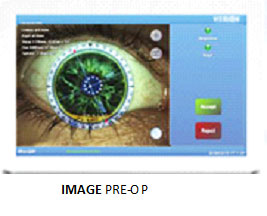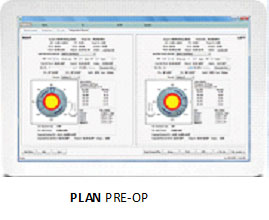Image Guided Cataract Surgery
The goal of cataract surgery with IOL implant is to help provide the best possible vision without glasses. Most people still require glasses for some or all activities. Sometimes calculations for the lens implant result in a strong prescription that is not tolerated by the patient. An additional surgical procedure may be required to correct the prescription or to replace the lens implant. Other ocular conditions such as macular degeneration, diabetes, glaucoma and other eye problems may prevent complete recovery of vision after surgery.
Cataract surgery is one of the safest surgeries performed, it has an excellent success rate. The rate of complications increases in people who have other eye diseases such as diabetic retinopathy or uveitis. All surgeries have risks, but for cataract surgery, complications are usually not serious.
Patient satisfaction with cataract surgery is high. But there is always the chance of those rare patients who are not happy with their results. Blurred vision and glare are common complaints in patients with certain IOLs.

In the past few years, cataract surgery has undergone many changes. From the way we perform surgery and the types of IOLs we implant to the methods we use to evaluate and counsel patients, these changes are all in direct response to our patients’ wants and needs. People who come in for cataract surgery today expect better refractive results than previous generations of patients, simply because most know about the precise outcomes that friends, family members, or they themselves have had with LASIK—a true refractive procedure that provides a high level of visual function without the need for distance correction. As baby boomers come into the cataract age, their desires are no different today at age 65 than they were 20 years ago when they had LASIK. In other words, they want to be independent of spectacles and contact lenses after cataract surgery. As a direct result of these heightened demands for cataract surgery and surgeons have made conscientious efforts to make cataract surgery a true refractive procedure.
Kenia Eye Hospital is proud to be one of the early few Eye hospitals in Mumbai to offer patients the new VERION™ Image Guided System. The VERION™ Image Guided System is designed to help surgeon customize and perform a procedure tailored specifically to patient’s eyes with computer accuracy.

This revolutionary technology creates a detailed map of the eye's unique features before cataract surgery for more precise lens placement during surgery. The Verion is designed for unsurpassed planning, accuracy, and efficiency throughout the cataract procedure.
This system is designed to minimize chances for error by creating a seamless link of data from the diagnostic machine to the operating room. Electronic transmission of information decreases the chance of human error that can occur when data is hand entered improving the accuracy of cataract surgery.

A high-resolution image is taken of the patient's eye, mapping out important details and measurements. This "map" allows the surgeon to more efficiently plan, and customize, each step of the procedure to the patient's eye. What's more, it provides greater accuracy and precision for the most important steps: the incision, as well as positioning and alignment of the intraocular lens, including those for astigmatic correction. The calculations and incision guides are flawlessly exported to other connected technology in the operating room during surgery.
Imaging: The Verion image guided system begins by capturing a high definition image of the patient’s eye. Using this image, the surgeon can create a blueprint of the best procedure for each patient. The position of a patient’s astigmatism can be precisely identified. This represents a breakthrough in surgical accuracy.

Planning: The reference unit is equipped with formulas to determine the correct intraocular lens power. Sophisticated algorithms based on data from many surgeons help determine the optimal incision location for which intraocular lens (IOL) to use, the best position for the intraocular lens (IOL) and where to place the corneal arc incisions to correct astigmatism. This information is then electronically transmitted to the Verion Digital Marker for use with the LenSx laser and the operating microscope.
Guidance: The data and precise plan is sent to the Verion Digital Marker mounted on the Phaco Machine in the operating room. Automatic registration of the patient allows for accurate centering of the intraocular lens (IOL).

How can cataract surgery be made more precise ?
Image Guided Cataract Surgery is the answer to superior visual outcomes ....
The pursuit of better visual outcome requires precise surgical execution to deliver repeatable consistent cataract survival outcomes ....
Cataract surgery is one of the safest surgeries performed, it has an excellent success rate. The rate of complications increases in people who have other eye diseases such as diabetic retinopathy or uveitis. All surgeries have risks, but for cataract surgery, complications are usually not serious.
Patient satisfaction with cataract surgery is high. But there is always the chance of those rare patients who are not happy with their results. Blurred vision and glare are common complaints in patients with certain IOLs.
Intraocular implantation helped to eliminate thick glasses after cataract surgery. Specialised intraocular lenses like Toric lenses, multifocal lenses, EDOF lenses helped to remove dependence on glasses in almost all cataract patients
To implant specialised lenses required good IOL centration and control of incision induced Toric changes or shape changes of cornea all this control required a technology which could plan, guide and control the execution of the steps of surgery.
The culmination of this precision in surgery became possible with IMAGE GUIDED SURGERY.
Kenia Eye Hospital is proud to be one of the early few hospitals in India to offer patients the new technology VERION™ Image Guided System. The VERION™ Image Guided System is designed to help surgeon customize and perform a procedure tailored specifically to patient’s eyes with accuracy.
This revolutionary technology creates a detailed map of the eye's unique features before cataract surgery for more precise lens placement during surgery. The Verion is designed for unsurpassed planning, accuracy, and efficiency throughout the cataract procedure.
This system is designed to minimize chances for error by creating a seamless link of data from the diagnostic machine to the operating room. Electronic transmission of information decreases the chance of human error that can occur when data is hand entered improving the accuracy of cataract surgery.
What is image guided surgery ?
The goal of modern cataract surgery with IOL implantation is to help provide the best possible vision without glasses. An eye having no comorbidities or eye problems which could compromise vision have the potential to be without dependence on glasses after cataract surgery.
To achieve good visual outcome requires pre surgical good measurements of the eye and calculations of intraocular lens power (number) as a first step.
Using a newer generation IOL power calculation formulas accurate results of near zero can be achieved in majority of cases.
Planning of the surgical steps and controlling and guiding the deviations from the planned steps with surgical inlay images is the key to deliver near accurate visual outcomes.
Image guided cataract surgery have an edge over the conventional cataract surgeries as they help and guide the surgeon to execute each surgical step according to pre-planned measurements. This image guidance helps to give an added benefit to give superior visual results.
World over leading eye surgical manufacturers have imbibed this technology of image guidance an added to the cataract surgical platforms.
Image guidance systems have two parts :
- Pre-surgical measuring and planning console
- Surgical device mounted on to the operating eye surgeons to guide the operating surgeon during eye surgery with eye onlay images.
A high-resolution image is taken of the patient's eye, mapping out important details and measurements. This "map" allows the surgeon to more efficiently plan, and customize, each step of the procedure to the patient's eye. What's more, it provides greater accuracy and precision for the most important steps: the incision, as well as positioning and alignment of the intraocular lens, including those for astigmatic correction. The calculations and incision guides are flawlessly exported to other connected technology in the operating room during surgery.
Imaging: The Verion image guided system begins by capturing a high definition image of the patient’s eye. Using this image, the surgeon can create a blueprint of the best procedure for each patient. The position of a patient’s astigmatism can be precisely identified. This represents a breakthrough in surgical accuracy.
Planning: The reference unit is equipped with formulas to determine the correct intraocular lens power. Sophisticated algorithms based on data from many surgeons help determine the optimal incision location for which intraocular lens (IOL) to use, the best position for the intraocular lens (IOL) and where to place the corneal arc incisions to correct astigmatism. This information is then electronically transmitted to the Verion Digital Marker for use with the LenSx laser and the operating microscope.
Guidance: The data and precise plan is sent to the Verion Digital Marker mounted onthe Phaco Machine in the operating room. Automatic registration of the patient allows for accurate centering of the intraocular lens (IOL).
All activities. Sometimes calculations for the lens implant result in a strong prescription that is not tolerated by the patient. An additional surgical procedure may be required to correct the prescription or to replace the lens implant. Other ocular conditions such as macular degeneration, diabetes, glaucoma and other eye problems may prevent complete recovery of vision after surgery.
Cataract surgery is one of the safest surgeries performed, it has an excellent success rate. The rate of complications increases in people who have other eye diseases such as diabetic retinopathy or uveitis. All surgeries have risks, but for cataract surgery, complications are usually not serious.
Patient satisfaction with cataract surgery is high due to technology and surgical skill delivering good visual outcomes.
In the past few years, cataract surgery has undergone many changes. From the way we perform surgery and the types of IOLs we implant to the methods we use to evaluate and counsel patients, these changes are all in direct response to our patients’ wants and needs. People who come in for cataract surgery today expect better refractive results than previous generations of patients, simply because most know about the precise outcomes that friends, family members, or they themselves have had with LASIK—a true refractive procedure that provides a high level of visual function without the need for distance correction. As baby boomers come into the cataract age, their desires are no different today at age 65 than they were 20 years ago when they had LASIK. In other words, they want to be independent of spectacles and contact lenses after cataract surgery. As a direct result of these heightened demands for cataract surgery and surgeons have made conscientious efforts to make cataract surgery a true refractive procedure.
Image guided cataract surgery is a real value addition in cataract surgery to match the patient expectation and to reap the benefits fully of the specialised new generation intraocular lenses for a superior quality high defined vision.